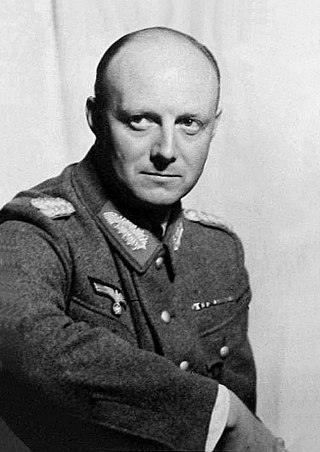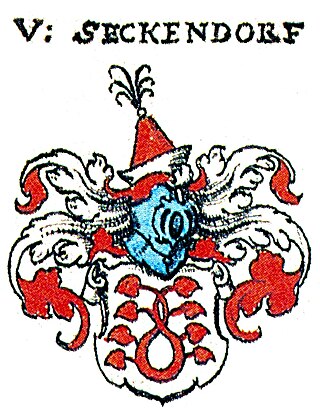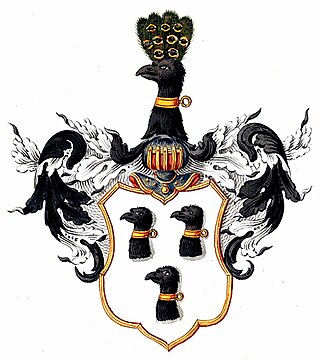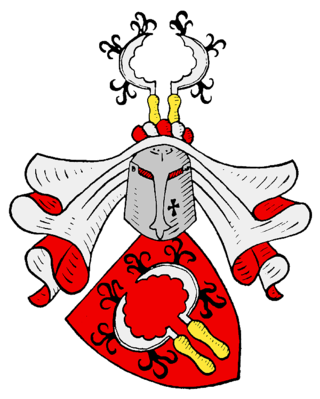
Henning Hermann Karl Robert von Tresckow was a German military officer with the rank of major general in the German Army who helped organize German resistance against Adolf Hitler. He attempted to assassinate Hitler on 13 March 1943 and drafted the Valkyrie plan for a coup against the German government. He was described by the Gestapo as the "prime mover" behind the plot of 20 July 1944 to assassinate Hitler. He committed suicide at Królowy Most on the Eastern Front upon learning of the plot's failure.

Johann von Hoverbeck was a Prussian diplomat. Hoverbeck's parents were Nikolaus von Hoverbeck, a derivative of a Flemish noble family, who emigrated in 1570 from Brabant to the Margraviate of Brandenburg, and Ursula Gutteter-Dobrodziejski, a derivative from a patrician family in Kraków. Johann von Hoverbeck, born in Aleksandrowice, a manor in the vicinity of Kraków, since 1614 attended the high school in Danzig (Gdańsk). Since 1624 he undertook an extended educational journey through Europe and visited France, the Netherlands, England, Italy and Hungary. He returned home in June, 1630. In 1631 he took up duties in governmental services of Brandenburg and dealt with foreign affairs, especially concerning Poland. He was an envoy of Brandenburg-Prussia in Poland from 1631 to 1682. He was a political architect and co-signer of the Treaty of Wehlau in 1657 and participated also in the Treaty of Oliva in 1660. During his political career he acted as an advisor to Frederick William, Elector of Brandenburg. As a gratification for his diplomatical achievements Frederick William presented to him in 1653 the manor of Eichmedien (Nakomiady) in Masuria, Duchy of Prussia. In 1663 the title of a baron war awarded to Johann von Hoverbeck.
Fabian Ludwig Georg Adolf Kurt von Schlabrendorff was a German jurist, soldier, and member of the German resistance against Adolf Hitler. From 1967 to 1975 he was a judge of the German Federal Constitutional Court.

The Hanseaten is a collective term for the hierarchy group consisting of elite individuals and families of prestigious rank who constituted the ruling class of the free imperial city of Hamburg, conjointly with the equal First Families of the free imperial cities of Bremen and Lübeck. The members of these First Families were the persons in possession of hereditary grand burghership of these cities, including the mayors, the senators, joint diplomats and the senior pastors. Hanseaten refers specifically to the ruling families of Hamburg, Lübeck and Bremen, but more broadly, this group is also referred to as patricians along with similar social groups elsewhere in continental Europe.

Barnim XI, son of Bogislaw X, Duke of Pomerania, became duke on his father's death in 1523.

The House of Franckenstein is the name of a feudal, Franconian noble family in Germany, descendants from the Dynasts of the Breuberg family; offsprings of the Lords of Lützelbach from Höchst im Odenwald.

The Gaffron family is the name of a German noble family - classified as Uradel - from Silesia.

The Berenberg family was a Flemish-origined Hanseatic family of merchants, bankers and senators in Hamburg, with branches in London, Livorno and other European cities. The family was descended from the brothers Hans and Paul Berenberg from Antwerp, who came as Protestant refugees to the city-republic of Hamburg following the Fall of Antwerp in 1585 and who established what is now Berenberg Bank in Hamburg in 1590. The Berenbergs were originally cloth merchants and became involved in merchant banking in the 17th century. Having existed continuously since 1590, Berenberg Bank is the world's oldest surviving merchant bank.

Schlieffen is the name of an old German noble family from Pomerania. The family, branches of which still exist today, originates in Kolberg.

Hobe is the name of an old German noble family from Mecklenburg, which also became influential in Denmark. Branches of the family are still in existence today.

Jean de Forcade de Biaix, aka Jean de Forcade, Marquis de Biaix, aka Jean-Quirin de Forcade de Biaix, aka Jean Quérin von Forcade, Herr von Biaix, aka Johann Querin de Forcade, Herr zu Biaix, aka Johann Quirin von Forkade de Biaix, was a Huguenot, a descendant of the noble family of Forcade and Lieutenant General in the service of the Kingdom of Prussia. He was the Regimentschef of the 23rd Prussian Infantry Regiment, Commandant of the Royal Residence in Berlin, Gouverneur militaire of Berlin, a Knight of the Order of the Black Eagle a member of King Frederick I of Prussia's "Tobacco Collegium". and president of the Grand Directoire 1718–1729, the deliberative and decision-making body responsible for all Huguenot affairs in the kingdom.

Friedrich Wilhelm Quirin von Forcade de Biaix, baptized Quirin Frideric de Forcade, aka Friedrich Quirin von Forcade, aka Frédéric Quérin de Forcade, was a Royal Prussian Lieutenant General, the second son of Jean de Forcade de Biaix, an early Huguenot immigrant to Brandenburg-Prussia and a descendant of the noble family of Forcade. He was one of Frederick the Great's most active and most treasured officers. He was wounded three times and once left for dead on the battlefield. Together with his wife, he fathered 23 children.
Friedrich Wilhelm Leopold Konstantin Quirin Freiherr von Forcade de Biaix, aka Friedrich Wilhelm Leopold Konstantin Quirin von Forcade de Biaix, Herr of Schleibitz, Hamm, Groß-Naedlitz and Loslau, aka the Baron von Forcade,, Royal Prussian Major, Knight of the Iron Cross 2nd Class on 26 August 1813, knighted by His Majesty Frederick William III of Prussia as Knight of the Order of Saint John in 1817, Royal Prussian Chamberlain (Kammerherr) and Castellan (Drost) of Neuenrade in the County of Mark, after his father's death in 1808. He was also a publisher, author, and theater director.

The Waldow family or Waldau, is the name of a Bavarian noble family. The family belonged to the German nobility in Nordgau. Originally a Prussian family, they became influential in Brandenburg in the 14th century. The earliest known ancestor is Knight Hentzlinus de Waldow. The family acquired land in Neumark, Meissen, Silesia and Pomerania, where they came to prominence and prestige that they retained until the Second World War.

The House of Seckendorff is the name of an old and prolific Franconian noble family. According to historian Werner Wagenhöfer, the Seckendorff family is the most researched family of the low nobility in Franconia along with the Guttenberg and Bibra families.

The House of Knabenau or von Knabenau is an ancient Baltic-German noble family of German origin, originally from Silesia, and later it spreads in the 16th century in Courland.

The House of Knesebeck is the name of two branches of a prominent aristocratic family in the tradition of the ancient nobility in Germany. In the 17th century they acknowledged a common ancestry and combined their arms. The black line of the family von dem Knesebeck stems from the ancient nobility of Lower Saxony, while the white line stems from the ancient nobility of the Altmark. Branches of both lines remain to this day. As one of the leading Prussian Junker families, it has produced numerous senior military and public figures. These have included ambassadors, bishops, governors, members of parliament, a field marshal, and dozens of generals.

The House of Schallenberg is the name of an old and important Austro-Hungarian noble family, whose members occupied may important political positions and were in diplomatic service.

The Treskow family is an old and prominent German aristocratic family, that descended as a branch of the medieval ("Uradel") House of Tresckow. The family rose to fame in Prussia due to their large landholdings and business ventures, resulting in many streets and boulevards being named after the family today.

The House of Lüttichau is an old German and Danish noble family that originated from Meissen, Saxony and belongs to the High Nobility. The family has several separate noble branches, primarily from Saxony, Denmark, Austria and Braunschweig. The Lüttichau family are amongst the largest landowners in Denmark today. Males of the family carry the title Baron or Imperial Count.



















